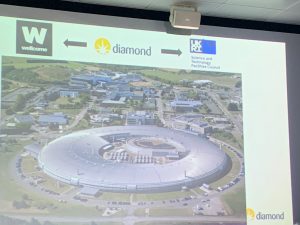Questers visit to Hampshire Record Office
05 April 2023
The current Hampshire Record Office (HRO) is housed in a purpose-built building which was opened by Queen Elizabeth II in November 1993 and is based in Sussex St, Winchester. (https://www.hants.gov.uk/librariesandarchives/archives/about-us) . Our trip was planned and co-ordinated with Sarah from the HRO over a number of months and was hosted on the evening by Heather and Jane. As it was a self-drive we all met in the foyer at the HRO and we were given an overview of the work and the purpose of the service, which is to provide specialist storage and restoration for historic documents of all types relating to Hampshire.
The archives come from a wide variety of sources, ranging over local government; religious organisations; families and individuals; businesses; schools; charities, societies and sports clubs; military organisations; hospitals; magistrates; coroners. Significant collections include those of Winchester Bishopric; Winchester Cathedral; prominent landowners and Hampshire families – including the Jervoise of Herriard archive and the Malmesbury archive; businesses, including Portals, papermakers; Church of England parishes and the Diocese of Winchester; The Royal Green Jackets regiment; Winchester City; local and regional TV and radio. The archives are complemented by the county Local Studies collection, a wealth of printed sources including directories, newspapers, pictures, and books on Hampshire localities, people and topics.
Some of the items we saw included the following:
- The earliest charter for the City of Winchester from Henry II 1155- 58 witnessed by Thomas a’ Becket
- A number of documents relation to the rental of Mottisfont Abbey 1340
- A large collection of photographs of the 1897 Queen Victoria’s Diamond Jubilee celebrations in Andover during which hundreds of soldiers in full dress uniforms paraded in the High Street followed by a street party which looked as though the whole town sat down at tables in the High Street to celebrate.
- A large number of everyday documents for example school reports, land sale documents, train posters which collectively trace the history of the county, in all over a million items that are all digitised and can be accessed online.
- A number of maps of the Andover area over the last 150 years.
We were shown the conservation department where documents that have been damaged by water, mould and vermin are preserved. A number of documents in different stages of decline were on show to illustrate the craft of the conservators and some of the different techniques for both wet and dry objects were explained. The conservation area was a large room containing specialist equipment and tables with lighting built in to enable detailed work to be done on objects. There are facilities for 3 conservationists to work alongside each other but due to reduction in spending in this area this has been reduced and funding is only adequate for one part time conservator at the moment.
There is also a photographic department where items are digitised for online access replacing the use of microfiche.
The Record office is always looking for new material to conserve for future generations and while we were there one of our members discussed the possibility of handing over the archive of the Andover Rotary to be made available, they may also be interested in other charity and community group memorabilia, just ask them. They are also interested in films and photos of significant local events taken by members of the public though do not guarantee to archive them all.
One of the highlights of a very interesting trip was visiting the cinema housed within the building where we saw a digitised film of a 1953 coronation celebration in Andover. We could all see some local landmarks and there were several comments from the audience about changes to Andover since then. I also heard one of the members identify their teachers from when they were at school about that time. The HRO also houses the Wessex Film and sound Archive (https://www.hants.gov.uk/librariesandarchives/archives/popular-records/wessex-film-sound-archive) which covers an area wider than Hampshire alone.
A very interesting tour which gave rise to questions, reminiscences and conversations – well worth a visit and they encourage people to contact them for assistance in accessing the records for their own research.
Kevin Barter


The camera for digitizing documents The Conservation area


The cinema The Reading and Viewing room






